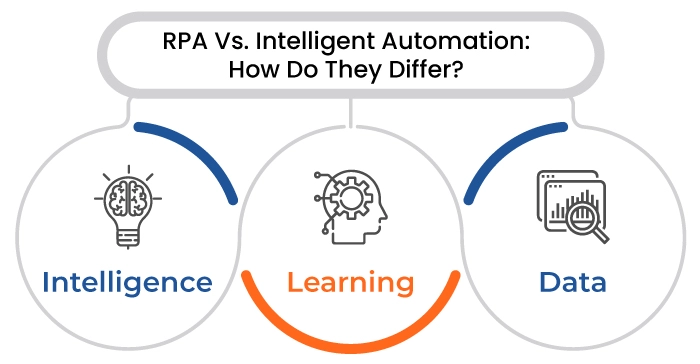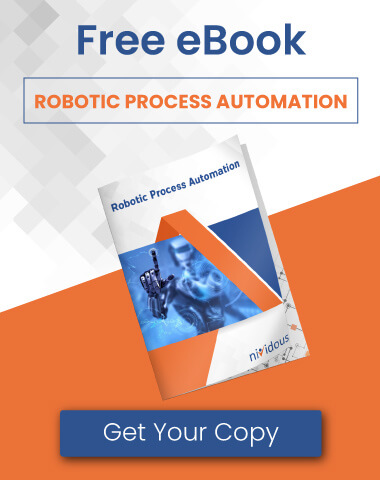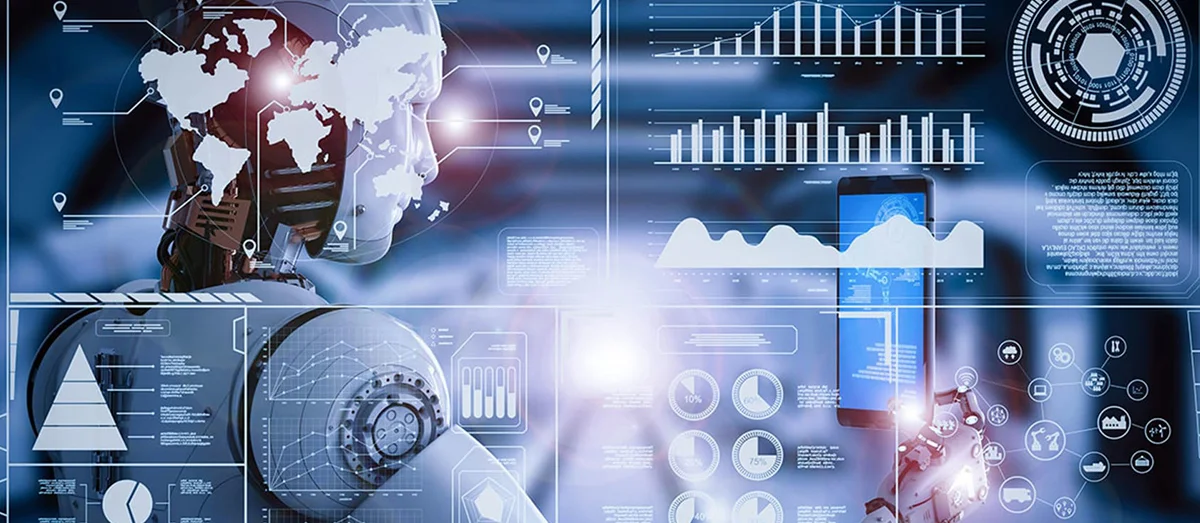While the robotic process automation (RPA) market is poised for remarkable growth, expected to reach a staggering $22 billion by the year 2025, there is a noticeable shift towards the adoption of more integrated intelligent automation (IA) solutions.
These IA solutions fuse advanced technologies such as artificial intelligence, machine learning, natural language processing, and low-code/no-code automation, creating a powerful synergy.
Businesses are increasingly recognizing the value of embracing a comprehensive, end-to-end automation strategy, and as a result, the adoption of IA technologies is on the rise. RPA is a stand-alone technology used for task-based automation but is also a critical component of the IA suite, operating in tandem with other advanced automation technologies to yield many benefits.
A deeper understanding of these technologies will show how their unique characteristics can be used in different ways to enhance operations.
What is Robotic Process Automation?
Robotic process automation (RPA) uses software to automate repetitive tasks. It is a rule-based solution that emulates human actions. Its goal is to improve productivity, operational accuracy, and ultimately help people spend more time on value-driven tasks.
To illustrate, consider the employee onboarding process, which often involves manually entering data into a payroll system through numerous forms. This not only entails mind-numbing repetition but also carries the risk of errors. RPA bots can efficiently capture information from the form and accurately transfer it to the payroll system.
Let’s take another example of a large e-commerce company that requires customer service agents to handle a multitude of customer inquiries and complaints daily. One common scenario involves customers seeking order status updates. Traditionally, this would require the agents to manually access multiple systems, cross-reference data, and provide the information to the customer. RPA bots can automatically retrieve order status information from various databases, cross-check it, and give customers up-to-the-minute details through chatbots or email.
As you delve deeper into this blog post, we will explore additional RPA use cases and success stories. If you want to uncover tangible benefits derived from RPA applications, read this detailed blog post.
What is Intelligent Automation?
Intelligent automation (IA) technologies go beyond replicating specific tasks by introducing a layer of intelligence to enable more complicated decisions and also adds orchestration to easily combine these technologies and others into a single, integrated solution. This combination empowers the automation of complex end-to-end processes to enhance operational efficiency.
Consider the labor-intensive task within Human Resources of sifting through an abundance of resumes. With resumes arriving in diverse and inconsistent formats, data extraction is far from routine. Here’s where intelligence, in the form of AI or Natural Language Processing (NLP), steps in. It can scan these resumes, extract vital information, and neatly arrange them into a standardized format. Subsequently, an RPA workflow seamlessly transfers this data to the HR system, where it is automatically assessed against a predefined set of criteria. The result? A concise list of the top five candidates for a job opening.
This remarkable synergy of IA components not only expedites the screening process but also ensures a more uniform and systematic evaluation, ultimately streamlining the recruitment procedure. Explore further instances of IA’s transformative capabilities by reading this detailed blog post.
RPA Vs. Intelligent Automation: How Do They Differ?

Intelligence
RPA lacks inherent intelligence, although it can follow simple rules, it can't adapt to changes or make decisions independently. On the other hand, IA technologies encompass cognitive capabilities to intelligently interpret and analyze information, making them well-suited for handling complex, non-routine tasks.
Let’s consider the example of invoice processing. The task of processing vendor invoices is inherently repetitive, and RPA can excel in speed and accuracy. An RPA bot can be trained to collect invoices from multiple sources. However, RPA bots need intelligence to extract data, given the variations in invoice formats across different vendors. Intelligent automation can effortlessly ingest invoice data using technologies such as Natural Language Processing (NLP) and artificial intelligence. IA not only standardizes the data for RPA processing but also possesses the ability to learn vendor-specific formats and adapt to deviations.
Learning
RPA bots operate based on predefined rules and instructions and lack the capacity for ongoing learning or adaptation. Once set up, RPA systems perform tasks as programmed, and any changes or new scenarios require manual adjustments. In contrast, IA systems can analyze data, adapt to changing circumstances, and improve performance over time by identifying patterns and making decisions based on past experiences. For example, an AI-enabled chatbot can refine its responses based on historical interactions and data points, identifying common customer pain points and optimizing its problem-solving capabilities.
Data
RPA is proficient at handling structured data, which is organized and follows a consistent format. It excels at automating repetitive tasks involving data entry, extraction, and processing within these structured datasets. Conversely, IA technologies exhibit the ability to handle unstructured data as well. This data type is often messy, diverse, and unorganized, such as text documents, images, and audio. IA systems can process and make sense of this unstructured data using natural language processing, image recognition, and other AI techniques. This makes IA more versatile and suitable for a broader range of tasks, especially complex, non-standard data types.
RPA and Intelligent Automation Success Stories
At Nividous, we have assisted numerous organizations in achieving their digital transformation goals through our integrated intelligent automation platform, simplifying their path to end-to-end automation. Our platform natively combines the capabilities of RPA, AI, ML, and low-code process automation/orchestration.
Automating insurance payments through IVR calls
One of our customers was grappling with a manual process that required deploying 50 call center agents to handle approximately 2000 IVR calls each day, involving multiple insurance carriers for payment processing. This highly manual approach posed a significant risk of errors, especially when dealing with sensitive information such as Personally Identifiable Information (PII) and Payment Card Industry (PCI) data. The Nividous intelligent automation platform revolutionized the entire process, including payment processing. Not only did the solution eliminate downtime, but it also allowed the customer to save over 500 man-hours per month and improve processing time by 30%.
Automating medical insurance claim submissions
For a leading medical billing company, the claim submission process involved manual verification, matching, and submitting patient records from internal Electronic Health Records (EHR) to an external portal. This process was monotonous, time-consuming, and error-prone. Additionally, there was a substantial backlog of approximately 6000 aged claim submissions, leading to further delays.
The Nividous intelligent automation platform helped the customer automate several tasks:
- Nividous RPA Bot identifies and classifies the claims and performs a series of steps based on defined business logic.
- The Bot enters data and validates field-level steps in Medicaid Insurance claims while verifying the correctness of data.
- The Bot saves ERA forms, uses them for form filing, and attaches them as needed for successful claim submission.
- Email triggers are scheduled to handle exceptions.
This automation has helped the customer reduce manual efforts and human errors by 75% and 70%, respectively.
Automation of numerous cross-functional processes
A leading transportation and logistics company has achieved 35% yearly growth without additional administrative overhead. This impressive accomplishment is the result of automating several cross-functional business processes, including invoice processing and accounts payable, as well as the generation of various reports and data validations. The Nividous platform has played a crucial role in enabling the customer to streamline their operations, resulting in significant improvements.
Are your intelligent automation investments delivering real ROI?
Join our live webinar on November 30, 2023, at 1 PM EST to discover strategies and frameworks for measuring genuine intelligent automation ROI that go beyond hard numbers.





![The Path Forward for Intelligent Automation [2024 Trends] Blog Feature](https://nividous.com/wp-content/uploads/2024/05/The-Path-Forward-for-Intelligent-Automation-blog-feature-1.webp)